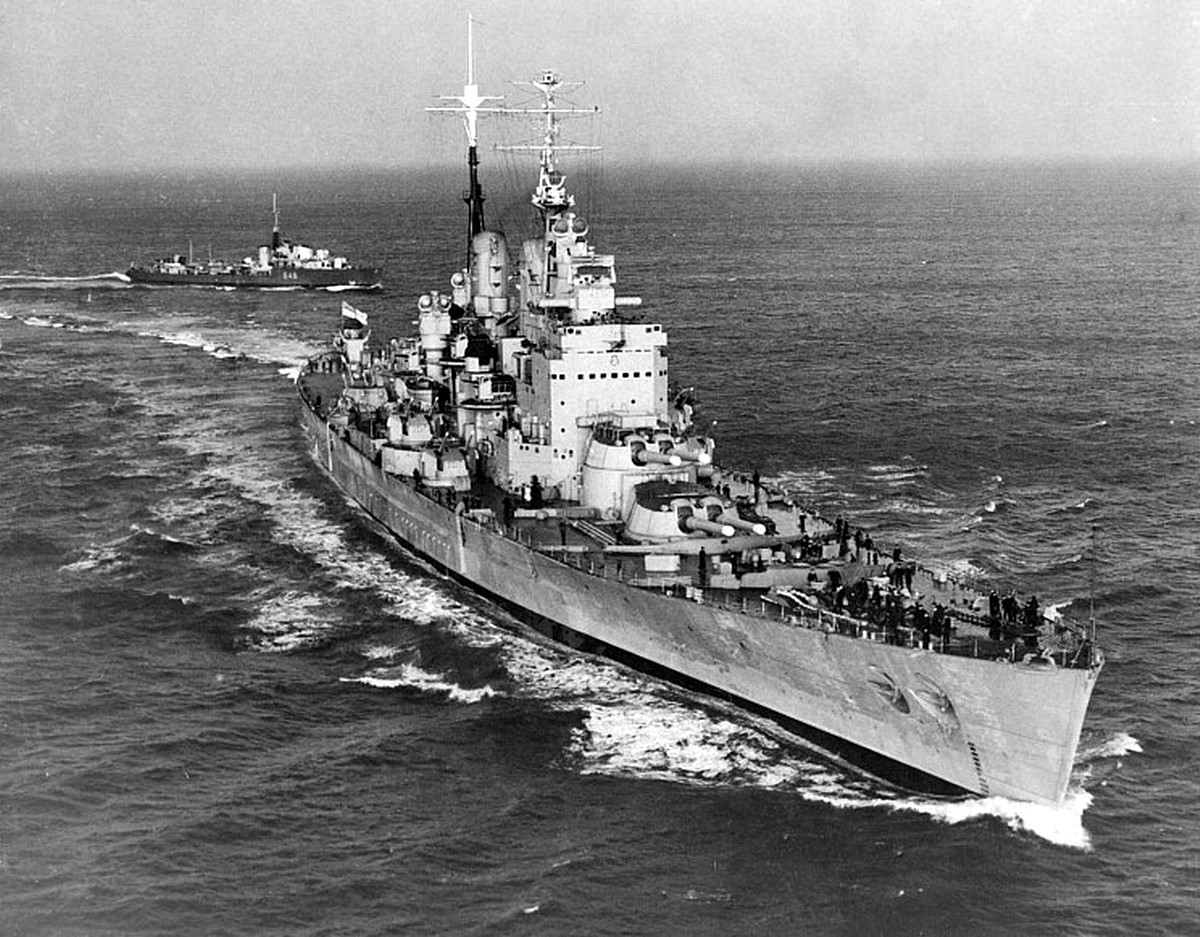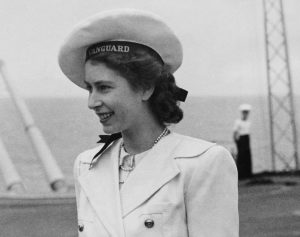- Author
- A.N. Other
- Subjects
- History - general, Ship histories and stories
- Tags
-
- RAN Ships
- None noted.
- Publication
- June 2016 edition of the Naval Historical Review (all rights reserved)
By Alf Batchelder
On 6 March 1948, the Melbourne Argus reported that ‘…never before in modern times has the sea-going strength of the Royal Navy been so low.’ After recent scrappings, Britain possessed only five battleships, all of which were immobilised, though two were being used as training ships. In London, the Navy League had angrily declared that the British Navy was ‘…completely powerless to maintain the national prestige or to protect in any way the national home.’ Some strategists even suggested that ‘…the day of the battleship, as we know it, is done’, predicting a future of nuclear and turbine propulsion in which wars would be fought with ‘a great new fleet of lone ‘atom raiders’.1
It was in this climate that an old fashioned use of the capital ship re-appeared. On Saturday 6 March 1948, just after Australians woke to the news that the federal government had no intention of abolishing wartime clothes rationing, Prime Minister Ben Chifley announced in a special 8.30 am radio broadcast that King George VI, Queen Elizabeth and Princess Margaret would travel to Australia in 1949 aboard the battleship HMS Vanguard. The proposed Royal Tour represented a throwback to the great days when Britannia ruled the waves and sent members of the Royal Family around the Empire aboard mighty capital ships.

HMS Vanguard, RN
Vanguard was built on the Clyde by John Brown and Company and launched by Princess Elizabeth on 30 November 1944, the first ship she had ever launched. However, the 44,500-ton battleship was not a totally new vessel. It has generally been accepted that her eight fifteen-inch guns had been removed from the First World War battlecruisers HM Ships Courageous and Glorious when those ships were converted to aircraft carriers in the 1920s, but recent research indicates that the guns came from a combination of five battleships and one monitor, with the four turrets being taken from Courageous and Glorious. In addition to her main weapons, Vanguard carried sixteen 5.25-inch secondary guns for close-in fighting and 73 x 40mm Bofors anti-aircraft cannons, the most on any British warship.2
Since Vanguard was capable of 30 knots, she was the fastest of all the Royal Navy’s battleships. At just over 814 feet (248.2 m) long, she was also the biggest, with a beam of 108 feet (32.8 m) and a deep load draught of 36 feet (11.0 m). Moreover, it has been said that, ‘with her flared bow, forward sheer, towering superstructure and her raked top funnels’, she was ‘the most handsome battleship ever built for the Royal Navy.’3
Though ordered in March 1941, delays, overruns and design changes delayed Vanguard’s completion, so that she was not commissioned until May 1946. After a few months of sea trials and training, modifications were carried out to enable the warship to transport the Royal Family to South Africa in 1947.
Serious efforts had been made in designing Vanguard to create a ‘homely’ atmosphere. The Age revealed that ‘her crew’s quarters for’ard offer an improvement so marked as to be almost revolutionary in the Royal Navy.’ Mess decks, recreation spaces and passage ways glowed ‘a soft green’, and seamen dined in ‘sponge-rubber cushioned seats at their mess tables’. Their food came from ‘a series of elaborate serveries, cafeteria system, with each man drawing his meal on a specially designed tray straight from electric heaters.’ Chrome-plated chairs of maroon leather furnished the recreation spaces, where maroon curtains over portholes toned with cream bulkheads, green baize-covered card tables and ‘tall chrome ash trays of the uncapsizeable variety’. Placed around the ship ‘at strategic points’ were sparkling canteens, and ice-cream and soda fountains. Aerated drinks, ice-cream and even beer were made on board. There were also libraries, ‘fit to grace any fair-sized town’, and ‘a properly appointed chapel caters for the ship’s spiritual welfare.’4
When the 1949 Royal Visit was announced, Vanguard was at Devonport for a refit that lasted until August 1948. During this time, the quarters usually set aside for the Admiral and high-ranking officers were prepared for the Royal Family. As had happened with the South African tour, most of the furniture for the Royal apartments came from the decommissioned Royal Yacht Victoria and Albert, and featured a predominantly blue and beige décor. All cabins had electric fires or radiators, ‘for which there is ample power in the ship’s circuits.’ The King’s day cabin possessed ‘a powerful radiogram’ but his most conspicuous piece of furniture was ‘a large business-like desk, at which he will work for some time each day on the voyage’.5
Meanwhile, a draft itinerary had been prepared for submission to the King. By August, it was understood that Vanguard would be ‘escorted for the entire journey by Australia’s first aircraft carrier, to be known as HMAS Sydney.’ In addition, the Royal Family would sail aboard HMAS Australia and Warramunga for their visit to the Great Barrier Reef.6

However, concerns about limitations on the role of HMS Vanguard arose early. Since her draught exceeded the 34-foot limit of the Suez Canal, she would be forced to travel to New Zealand and Australia through Panama. Initially, it was intended that Vanguard would convey the Royal Family to the major Australian ports but, in mid-April, the Age reported that the battleship’s ability to enter Port Phillip Bay had become ‘the subject of an official exchange of information’.7
In pointing out that the depth of water at the Heads was 43 feet, and noting that the battleships HM Ships King George V and Ramillies, as well as the 42,348-ton liner Empress of Britain, had visited Melbourne, the paper explained that ‘in calculating the permissible navigating draught, allowance had to be made for scend and weather and tide conditions.’ It was recalled that, in 1920, when fog delayed HMS Renown off the Heads in 1920, the Prince of Wales had been transferred to the destroyer HMAS Anzac for the journey up the bay, so ‘that idea might be followed in the case of Vanguard.’
Since the Harbour Trust believed that, ‘by dredging the channels, the Vanguard could berth at Port Melbourne’, the Victorian government intended to submit plans to the Naval Board for deepening the channels at Port Melbourne and at the entrance to Port Phillip Bay. At the same time, hopes were expressed that the Royal Family would land at Portland or Western Port. While the latter suggestion roused significant official interest, ‘the only chart in use … was one drawn from data obtained by Commander H.L. Cox, R.N., in 1865.’ The Age observed that, as this chart ‘was based in little more than sketch scale … it was inadequate for a ship as big as Vanguard.’ The sloop HMAS Warrego therefore carried out a two-month survey of Western Port, with the result that organisers decided to commence the Royal Tour of Victoria on May 11, 1949, with a King’s Review at Flinders Naval Depot, after Vanguard had anchored offshore.8
Doubts had also been expressed about Vanguard’s ability to berth at Brisbane, Adelaide Fremantle, Bell Bay and Burnie. Further uncertainty came from a report that the Admiralty ‘may assign the Vanguard to active service because of the deteriorating international situation’ but Prime Minister Chifley dismissed the suggestion as ‘mischievous’. By late 1948, functions for Vanguard’s crew were being organised around the country, and anticipation was building for the appearances of the 53-man Royal Marine Staff Band which was scheduled to ‘give concerts ashore from a repertoire of 3,000 pieces.’ On November 23, though, in another morning broadcast, Mr. Chifley announced that circulation problems in the King’s right leg had caused the Royal Tour to be postponed indefinitely.9
After a brief spell in 1949 as flagship of the Mediterranean Fleet, Vanguard spent most of her active life as the flagship to the various units to which she was assigned. In 1955, the Admiralty announced that she would be placed in reserve after a refit. Known to her small crew as ‘Britain’s Mightiest Mothball’, Vanguard was condemned to the scrapyard in October 1959. On June 7, 1960, Rear-Admiral John Grant watched as her White Ensign was lowered for the last time. He later said: ‘The last sunset of any ship is inevitably a sad occasion and this one more so because it marks the passing of a type of ship. The battleship is out of date and has now been replaced as a capital ship of the fleet by the aircraft carrier’.10
The YouTube video HMS Vanguard– Britain’s Last Battleship shows her scrapping which is sad viewing – see https://www.youtube.com/watch?v=Db6bgu0gs-g.11
Sources:
- The Argus, March 6, 1948, p.4; The Goulburn Evening Post, March 9, 1948, p.2.
- Military Factory website,http://www.militaryfactory.com/ships/detail.asp?ship_id=HMS-Vanguard-23.The Life and Times of the Royal Navy Battleship HMS Vanguard website,
http://battleshiphmsvanguard.homestead.com/15inch.html
- McCart, Neil: HMS Vanguard 1944-1960 – Britain’s Last Battleship, Liskeard, 2001 p.v.
- The Age, May 1, 1948, p.6.
- The Goulburn Evening Post, June 21, 1948, p.5.
- The National Advocate(Bathurst), August 9, 1948, p.2; The Courier Mail(Brisbane),
September 8, 1948, p.3; The Daily Examiner(Grafton), August 25, 1948, p.1.
- The Argus, April 15, 1948, p.3; The Age, April 17, 1948, p.3.
- The Argus, April 30, 1948, p.1; August 25, 1948, p.1;The Sydney Morning Herald,
April 30, 1948, p.3; The Portland Guardian, April 29, 1949, p.2; The Age, September 2, 1948, p.2.
- The Northern Star(Lismore), October 8, 1948, p.1; The Newcastle Sun, October 8, 1948, p.10; The Goulburn Evening Post, June 21, 1948, p.5; The Evening Advocate(Innisfail), November 23, 1948, p.1.
10.McCart, Neil: op.cit., pp.90-92.
11.https://www.youtube.com/ watch?v=Db6bgu0gs-g




